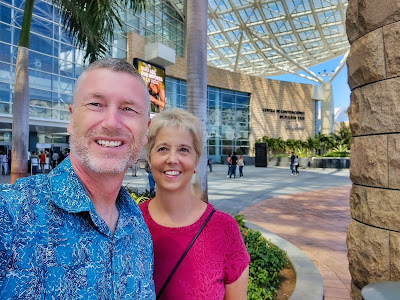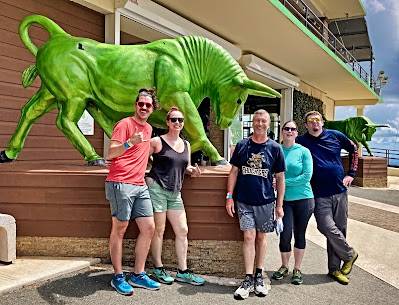Roman Holiday
Have you ever watched any of those old movies from the 50’s?
A while back we saw Roman Holiday featuring Audrey Hepburn as a visiting princess who sets out on her own to experience Rome as a common tourist. Gregory Peck co-starred as a reporter who meets her and falls in love while they visit all the wonderful sites of the city. Great film.
Many of those classic movies were filmed on location in various countries of Europe. They served as a kind of travelogue for non-traveling Americans, wowing audiences with stunning vistas and beautiful cities in addition to entertaining them with a romantic comedy storyline.
So glad we live in an era where travel is more accessible to the average person and we don't have to just view the sites on video. We can actually go there and create our own adventure!
In 2018, we went with friends on a great two week vacation to Italy. Our first stop was the beautiful and historic City of Rome. After settling in our hotel, we headed towards the iconic Spanish Steps to experience our own Roman holiday!
 |
| Julie and Dianne loving that gelato! |
Two interesting things of note regarding the Spanish Steps. First, although Audrey Hepburn was shown eating a gelato on the Spanish Steps in the Roman Holiday film, current laws prohibit eating food or snacks on historic sites and monuments in order to guarantee the protection of areas of merit in the historic center.
 |
| Julie at the Spanish Steps. No gelato! |
Second, the name itself. Why are they the Spanish steps? The 138 steps themselves were designed by an Italian architect and funded by a French diplomat in order to link the church and Spanish Embassy at the top of the steps to the Holy See in the Square below. A very European building project!
 |
| At the top of the Spanish Steps in Rome. |
Next stop is the famous Trevi Fountain. It was beautiful, crowded, and well guarded by uniformed police officers. As the sun began to set, even more people gathered around the fountain. The famous tradition at the fountain? Throw in a coin and you will return to Rome. We most certainly did toss in a coin!
 |
| Trevi Fountain at Sunset. |
That evening, we met up with a tour guide for some more historical context of the center city and a walk to the Trastevere neighborhood to experience aperitivo time. Some might compare this to the American Happy Hour, but it’s not really.
The truth is that aperitivo is almost a philosophy for Italians. You are spending non-rushed time with family or friends, sharing with each other over conversation, food, and drink. The idea of an aperitivo drink is to prepare your digestive system for the upcoming 3-5 course meal. Typical aperitivo drinks include the Negroni, the Aperol Spritz, or a simple glass of Prosecco. The food samplings usually consist of meat, cheese, and vegetable samplings.
Another fascinating adventure in Rome was exploring Ancient Rome. Our ambitious agenda included stops at Colosseum, Palatine Hill, the Forum, Capitoline Museums, Trajan's Column, and the Pantheon. Whew! And did I mention that it was unusually hot for September? During the heat of the day, the temperature was well into the 80s. Still, a great day for walking and enjoying Old Rome.
 |
| The Roman Colosseum. |
After nearly a decade of construction, Emperor Titus, in A.D. 80, officially dedicated the Colosseum with a 100 day festival of games in the new amphitheater. There, the public gathered to watch gladiatorial combats and other forms of entertainment. Seating for 50,000-80,000 spectators also included retractable awnings to protect the crowds from the sun.
Such “games” included mock naval engagements where they flooded the floor of the arena with water; hunting expeditions with live wild animals and imported trees and foliage; and even combat between gladiators and various wild animals. Combatants were generally slaves, condemned criminals, or prisoners of war.
The remnants of the Arch of Constantine and the Roman Forum with its temples, courthouses, markets, and administrative buildings gave us a look back into Roman city life. One of the most interesting things that struck me was, as you worked your way up and down the historic layers, you were stepping into so many different centuries. It really was amazing.
 |
| The Locks of St. Angelo Bridge. |
We also crossed the St. Angelo Bridge with its famous locks of love - with actual locks attached to the railing of the bridge. Recent tradition has young lovers “lock their love” on the bridge as an enduring symbol. Had we known, we would have come prepared with a lock in hand! Someone was missing out on selling them nearby!
This Roman bridge over the Tiber river led to the mausoleum of Roman Emperor Hadrian. In the 1500s, Pope Clement VII collected a toll at the bridge and commissioned Italian Sculptors to add the 8 angels on the bridge, including one by Bernini.
The last Roman highlight we visited was the Vatican area. St. Peter’s Basilica and the Vatican Museum were amazing. The architecture, the art and famous artists, the brilliance of the marble and gold, and the detailed biblical storytelling all combined to provide a great appreciation of what we were seeing in one place.
 |
| Ceiling of the Sistine Chapel. |
I would love to show you some photos of the Sistine Chapel, but alas, none were allowed. Squished together in pre-COVID fashion we were herded into this amazing room filled with ornate and detailed frescoes. The Sistine Chapel takes its name from Pope Sixtus IV della Rovere who commissioned the frescoes in the 1480s. Stories from Genesis through Revelation adorn the ceilings and the walls.
Our trip to Rome was like stepping back in time, we visited so many historical periods in one place. It was a time to reflect on the past while enjoying the present. Simply amazing! Made all the more special because we traveled with some good friends and experienced the city together. We weren’t royalty in disguise, of course, just regular people enjoying a fantastic locale.
If you are planning a trip to Italy, be sure to carve out some time to experience your own Roman Holiday!




Comments
Post a Comment
Thanks for commenting. We check our messages regularly and enjoy interacting on our blog!